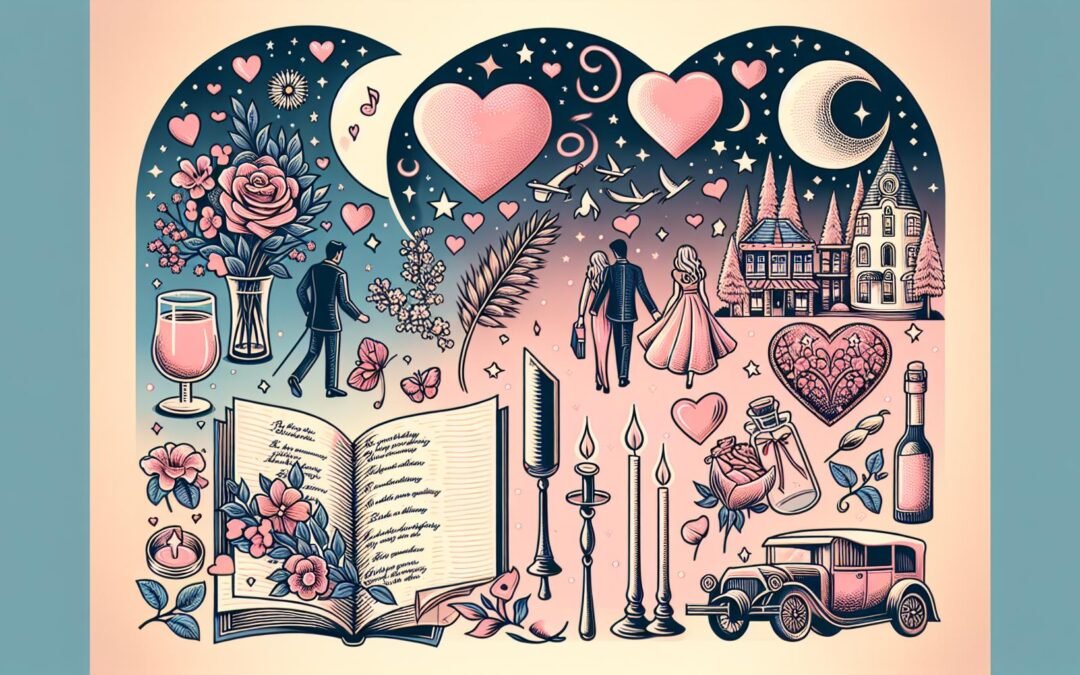Short love poems concentrate centuries of passion, longing, ecstasy, and heartbreak into forms few in line or word, but rich in feeling and ingenuity. In Sappho’s surviving fragments, a single verb or image breathes the full thrill of desire, while the symmetry of Persian ruba’i expresses yearning cloaked in riddle or paradox. Lives and cultures change, but the magnetic intensity of brief poetic confession remains evident from medieval courtly songs to today’s Short Sweet Poem For Her.
Short Love Poems: Historical Traditions
The legacy of short love poems begins with Sappho, who used phrase and image to catalyze physical and emotional force. A lover’s trembling, the glare of a rival, the shade of night sliding across skin—each fragment models lyric intimacy. Sappho’s work, written in Aeolic Greek, animates yearning through compression. No extraneous word appears; the fragmentary state sharpens every syllable. This influence set a precedent for the individual voice in lyric verse, a principle explored in other ancient traditions.
Chinese and Persian Quatrains: Jueju and Rubaiyat
Chinese jueju from the Tang dynasty, popularized by poets Li Bai and Wang Wei, embrace formal boundaries by employing four lines with strict tonal patterns. Physical absence, a single bamboo shoot, or the hush of moonlight transform into tokens between separated lovers. This elegant form fosters ambiguity and suggestion. Persian rubaiyat, as shaped by Omar Khayyam, infuse philosophical depth into concise verses. Ruba’i quatrains unite sensuality and metaphysical doubt, prompting reflection through elegant restraint. The rubaiyat’s clarity appealed to later generations, influencing innovations in Europe and beyond. More details about such forms appear within the article Famous Short Love Poems.
Medieval Troubadours and European Lyric
In medieval southern France, troubadours and trobairitz created short forms for courtly love. The canso celebrates admiration or agony in formalisms as short as six or as long as ten lines, favoring repetition and refrain. Occitan alba depicts lovers seized by separation at dawn. During the later Renaissance, Italian and English writers established the sonnet’s structure at fourteen lines, using its volta or “turn” to dramatize the pivot of devotion or doubt. The form’s fixed length generated new strategies for surprise and reversal. Shakespeare’s sonnets frequently close with an inseparable couplet, distilling sentiment to its irreducible core. The continuing adaptation of these forms is discussed thoroughly in Short Poems About Heartbreak.
Japanese Haiku and Tanka
Japanese poets brought attention to the relationship between brevity, seasonality, and memory. The haiku, restricted to three lines with a 5-7-5 syllabic structure, rarely addresses romance directly but encodes longing and beauty through direct observation. The tanka, with five lines and a 5-7-5-7-7 pattern, broadens these possibilities, leaving space for personal reflection alongside natural imagery. Saigyō and later Yosano Akiko illustrate how fleeting encounters, changing weather, or the opening of a fan can signify unspoken emotions. Haiku’s international spread invited new generations to reimagine intimacy through silence and omission. Many Short Poems To Make Her Melt draw on such imagery.
Form, Technique, and Defining Qualities
Short love poems demand concision, which distinguishes them from extended lyrics or narrative works. Generally under fourteen lines, the dominant forms include two-line couplets, four-line quatrains, three-line haiku, epigrammatic fragments, and even single sentences. A concern for economy governs each tradition, with content focused sharply rather than spread across digression or subplot. The formal boundary set by length or syllable guides, but emotional concentration—every word required, no surplus tolerated—makes the difference. Even a simple quatrain, as seen in Short Love Poems For Her, can harbor nuance and tension.
Couplets, Quatrains, and Beyond
Quatrains, from the jueju to the Persian ruba’i, balance symmetry and suggestion. Martial’s Roman epigrams distill irony or sensuality in concise Latin lines, while Emily Dickinson’s short stanzas focus emotional ambiguity. Rumi employs couplets in the masnavi, though his poems may extend for hundreds of lines; select passages explore connectedness in just a handful of phrases. The haiku, tanka, and shorter forms in Western languages encourage the unsaid to take center stage. This tension between presence and absence distinguishes works collected in Short Love Poems For Him.
Sound, Structure, and Musical Devices
Rhyme provides unity or playful closure, a function evident in both Eastern and Western traditions. End rhyme signals completion, while slant and internal rhymes suggest tension in a relationship or feeling. Meter varies: classic iambic pentameter sonnets emphasize the measured uncertainties of passion, while syllabic forms increase discipline. Free verse, more common in recent eras, abandons traditional patterning for rhythms influenced by speech and emotion. Briefness does not indicate structural freedom; instead, form becomes an instrument of pressure. The strategic use of enjambment highlights significant turns and hesitations, as seen in many short romantic poems.
Metaphor and Imagery
A short poem transforms a direct experience into metaphor or symbol. Sappho’s use of the green apple, flowering narcissus, or the image of a lover’s tongue responds to the limitations of form with condensed sensuality. Japanese poetry’s frog, rain, or mountain path signals more than surface: memory, longing, regret, or the passage of time. In twentieth-century poetics, H.D., Pablo Neruda, and Agha Shahid Ali demonstrate new metaphoric density, using a single object—a window, a stone, the flicker of a candle—to stand for a world withheld.
Ambiguity, Silence, and Suggestion
The greatest power of the short love poem emerges from suggestion. A break in syntax, a half-spoken pronoun, or the abrupt end of a fragment draws the reader’s emotion and intellect into the text. Sappho’s surviving “Someone will remember us” does not reveal who, how, or when, allowing endless re-creation in the mind of a reader. Dickinson’s stanzas leverage punctuation and caesurae to mimic longing and loss. In contemporary micro-poetry, resonance lingers long after the final line. Recent studies at Academy of American Poets explore how poets employ negative space to intensify feeling.
Themes, Motifs, and Emotional Resonance
Desire, anticipation, separation, and fulfillment populate short love poems across history and language. A green apple left unplucked, the pause before an answer, the glow fading at dawn—these recurring motifs elevate ordinary moments into sites of emotional disturbance. Fulfillment appears rarely; most short love poems pivot on yearning, regret, or possibility instead. Many of these themes feature in Short Love Poems For Wife.
Physical, Spiritual, and Metaphysical Love
Short poems trace connections between body, spirit, and the ineffable. Rumi, Hafez, and later mystics translate touching a hand, or glimpsing a face, into revelations about divinity and passion. The language of intoxication—wine, scent, quick breath—overlaps with invocation of the soul’s ascent. In Sappho and Catullus, the division between eros and the sacred dissolves, and love’s articulation becomes itself a form of worship. Shakespeare and John Donne create similar ambiguity, compressing metaphysical conceits into single stanzas examined in Short Love Poems For Husband.
Impermanence, Memory, and the Present Moment
Time asserts its presence strongly in the short love poem. Haiku pivot on a solitary instant: leaf fallen, rain striking ink. The sonnet’s turn serves as a temporal hinge, revealing how longing and fulfillment split across seconds. Modern texts in Spanish, Urdu, and English situate the poem at the edge of departure, using absence as a narrative device. In Best Short Love Poems, quicksilver images capture the breath before a farewell or the sensation of a lover vanishing.
Technological Change and Contemporary Forms
Innovation extends through the present, as the era of print gave way to the rapid sharing of micro-poetry and text-based confessionals online. Poets now use character limits, image overlays, or context-specific delivery to revive poetry’s power in the every day. Personal pronouns and direct address flourish: “I love you” or “I miss you” appear as direct as possible. Social platforms have produced new classics and reinvented familiar tropes, broadening reach and further condensing message. Resources like Love Poems Short And Sweet demonstrate the ongoing vitality of this tradition.
Extensive resources and contemporary examples of how brevity shapes emotion are available at established educational domains including Poetry Foundation. This evolving tradition remains one of the most vibrant in global literature.

